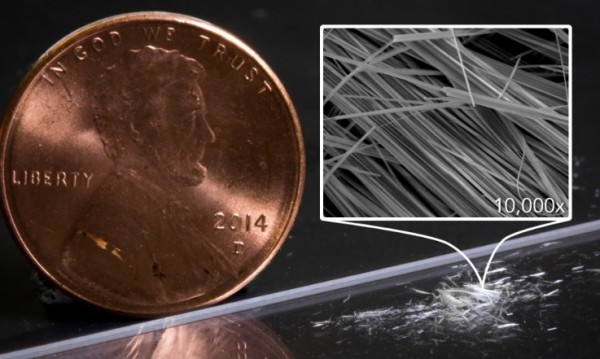By Ana Verayo, | December 28, 2016

Fuzzy white clusters of nanowires on a lab bench, with a penny for scale. (Hao Yan/SIMES/SLAC National Accelerator Laboratory)
Scientists have created the smallest electrical wire ever, only measuring three atoms wide, with the help of the smallest units of diamonds called diamondoids.
A team from Stanford University and the US Department of Energy's SLAC National Accelerator Laboratory used self-assembling diamondoids to achieve precision and control over non-invasive techniques in conductive wires.
Like Us on Facebook
According to Stanford's Hao Yan, they have developed tiny, conductive wires of the smallest possible size that can assemble themselves using a simple, one-pot synthesis. Yan said that by dumping all the ingredients together, the results will yield themselves in half an hour, where the diamondoids always seem to know where they want to go.
These diamondoids surround the semiconductor core made from chalcogenide which is a combination of copper and sulfur. They also serve as both insulator and assembly toolset.
According to Stanford's Nicholas Melosh, this technology can be weaved into energy generating fabric and more importantly, serve as a versatile toolkit to create new materials with electrical properties and interesting physics.
Scientists sort the diamondoids by size from petroleum fluids where they choose diamondoids that are made from 10 carbon atoms with a single sulfur atom attached to each carbon atom. The diamond bits are then placed in a solution where the sulfur atom can bond with a copper ion.
When the copper ion is bonded to the sulfur atom, the diamondoids behave like magnets where they create a force known as the van der Waals equation. When these atoms attach to each other, they create a nanowire made from sulfur and copper ions.
According to Stanford's Fei Hua Li, these are similar to LEGO blocks as they can only fit together in certain ways depending on their size and shape. The copper and sulfur atoms merge thus forming a building block and then creating a conductive core of the wire. The diamondoids are heavier, and they form the insulating shell of this building block.
Using this diamondoid assembly method, the team was able to build one-dimensional wires from zinc, iron, silver, and cadmium. Practical applications include improving optoelectronics, light emitting diodes, and solar cells.
This new study was published in the journal Nature Materials.
-
Use of Coronavirus Pandemic Drones Raises Privacy Concerns: Drones Spread Fear, Local Officials Say

-
Coronavirus Hampers The Delivery Of Lockheed Martin F-35 Stealth Fighters For 2020

-
Instagram Speeds Up Plans to Add Account Memorialization Feature Due to COVID-19 Deaths

-
NASA: Perseverance Plans to Bring 'Mars Rock' to Earth in 2031

-
600 Dead And 3,000 In The Hospital as Iranians Believed Drinking High-Concentrations of Alcohol Can Cure The Coronavirus

-
600 Dead And 3,000 In The Hospital as Iranians Believed Drinking High-Concentrations of Alcohol Can Cure The Coronavirus

-
COVID-19: Doctors, Nurses Use Virtual Reality to Learn New Skills in Treating Coronavirus Patients







